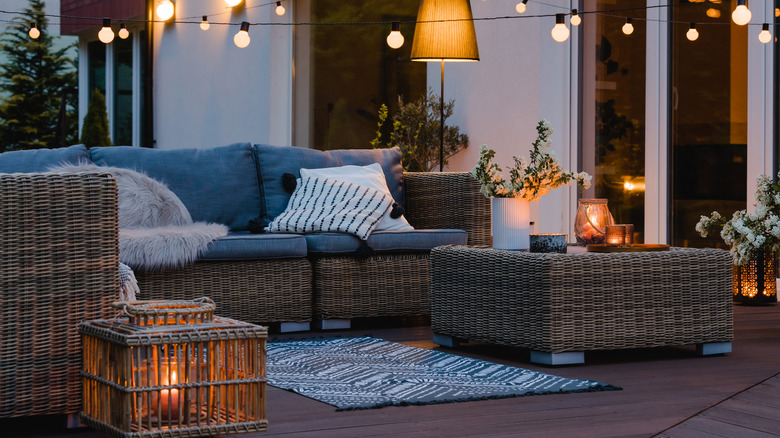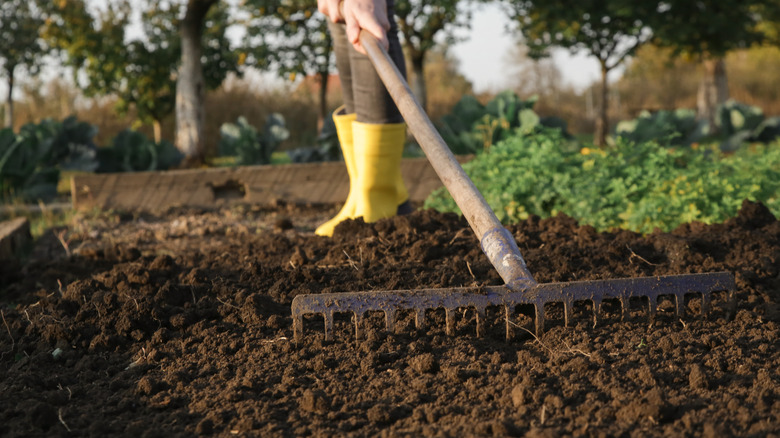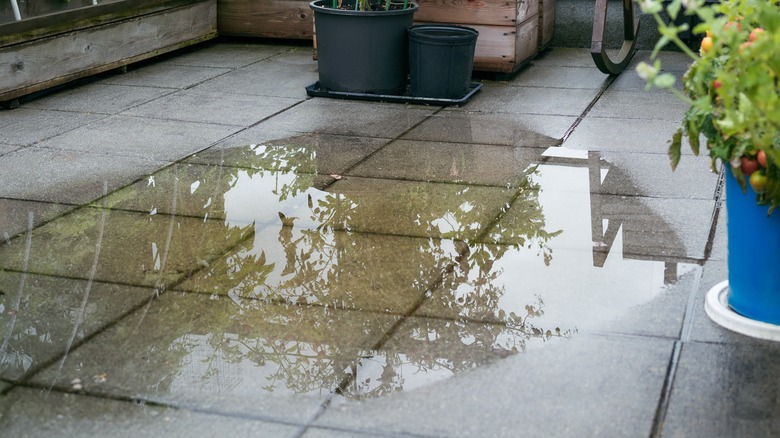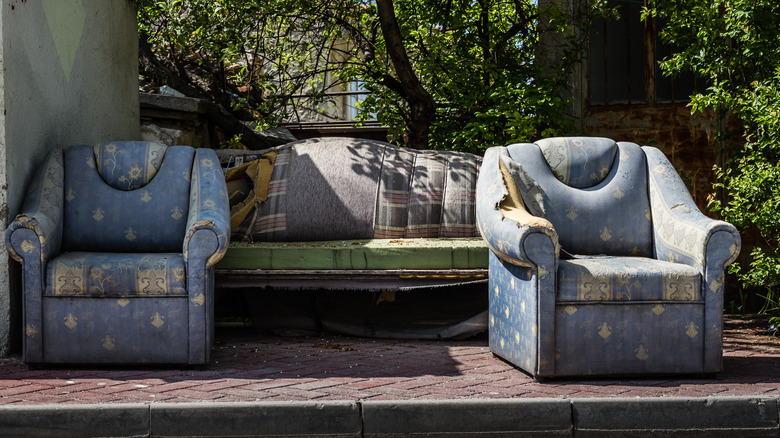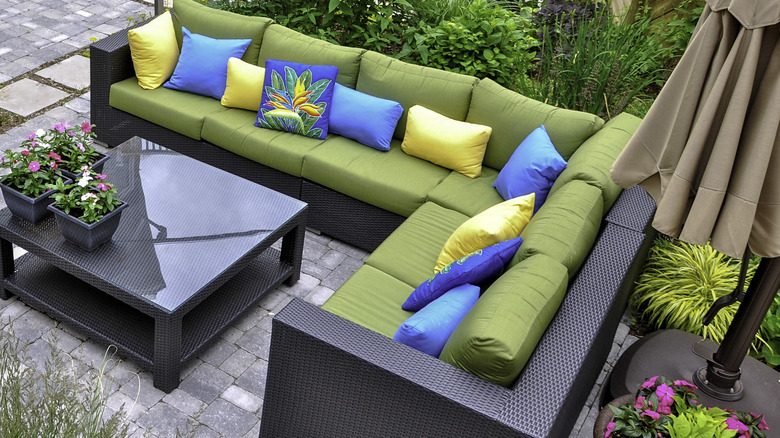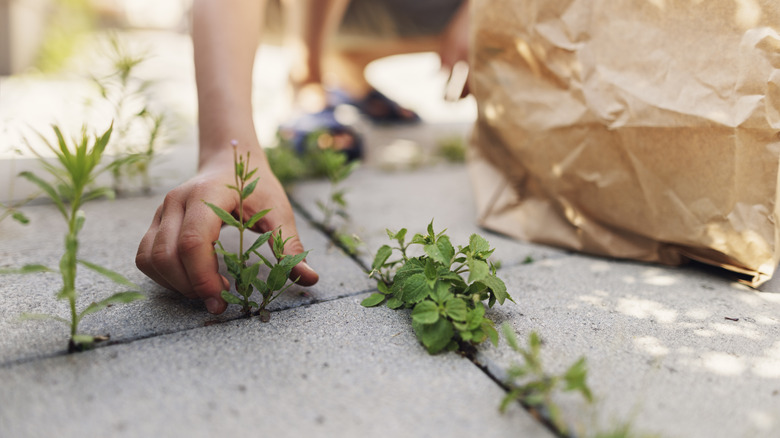Designing A Patio? Avoid Making These Mistakes
A patio is one of the best ways to create a functional, stylish outdoor space and add value to your home. Patios can also be DIY'd much more easily than other outdoor areas like balconies and decks. They're built to be flush with the ground, which means you don't need to worry about climbing ladders or installing a railing. Further, they come in all sorts of sizes and can be built out of a variety of materials. But if you're designing your own patio area, there are some key mistakes that can make the project a total bust, such as not preparing properly, not considering your typical weather conditions, buying unsuitable furniture, or not maintaining the patio.
These aren't always obvious and they don't just happen in one phase of patio designing. They can occur at any time during the planning, building, and shopping phases and can even happen long after your patio has been installed. Before you embark on your dream patio journey, learn more about these crucial patio design errors and how to avoid them to get the most out of your outdoor space.
Not preparing the ground properly
Once you've decided to take on a new DIY project, it's very tempting to just check out your Pinterest board, rush to the home improvement store, and get cracking. But don't neglect actually preparing the area of your yard where you'll be building your patio. Regardless of the pavement material you'll be using, you want to go over this land and get rid of unwanted stones, gravel, and weeds, as these can obstruct your pavers and slow down the installation process. Remove any rolls of turf and shovel out grass as well.
If your yard is very uneven and will require more than just raking and compacting a layer or two of dirt over some low points, you'll want to level it properly. You can follow our smart tips for leveling your backyard and find the right method for your skill set and budget, such as a laser gauge or simple spot leveling. This will give you a smooth, even surface, which makes a huge difference for ease of installation and means you won't be tripping and catching yourself on uneven pavers. As a word to the wise, some yards will require digging in order to be leveled — if this ends up being true in your case, make sure you aren't digging in an area that has plumbing pipes or electric wires buried beneath to avoid causing damage.
Failing to design for your region's climate
If you live in a utopia that has 365 days of sunshine and moderate temperatures per year, then feel free to skip this slide. For the rest of us, it's absolutely key to build your patio for your regional climate conditions. Otherwise, you won't be able to enjoy as many days on your patio, and you can end up damaging it over time.
To start, if you live in an area that receives a lot of rain and snow, you want to choose a patio material that can withstand plenty of moisture. The best choice for high-moisture areas would be a material that's either non-porous or low porosity, such as natural stone, porcelain tiles, or concrete. But that isn't to say you can't also use porous materials like wood. You'll just want a type that is naturally water-resistant, such as teak, and you'll need to seal it with a good weatherproofing varnish to keep water out. Another important piece of equipment to install on any patio in a wet or snowy area is a drain, which will keep your patio from flooding, potentially damaging both the patio and furniture.
In hot, arid climates, you want to choose materials that won't be bleached or dried out from the sun. Stone, clay, and concrete are all good options here. You can also seal wood flooring panels and furniture in a UV-protective coating.
Using indoor or non weather-resistant items
When you begin shopping for patio furniture, you may be shocked to see the price markup for items that are labeled as outdoor-friendly. You may think it's a better choice to just buy the more affordable pieces that were built for indoor use, or maybe you found a stunning loveseat at the thrift store that you're dying to use on the new patio — especially if it's covered. However, this is a huge mistake. Part of what makes patio furniture so much more expensive is that each piece of it, from the wood to the fabric, has been specifically designed to endure outdoor conditions. That includes the sun, rain, wind, and all sorts of weather. Because interior furniture was only designed for indoor use, the materials are much more delicate. Put under the same conditions as the patio furniture, indoor furniture will show signs of wear and tear much more quickly.
For instance, an outdoor wooden bench will likely be built with a low-porosity wood, meaning water won't be able to get in as easily. It will also be sealed to keep the wood protected from the elements and conditioned to stay looking great. The materials for regular indoor furniture were not selected with this same intentionality. Since there would be more extensive damage to those indoor-only pieces, you would likely end up having to replace the items quickly anyway, so the money saved wouldn't last for long.
Choosing the wrong size furniture
When you first buy a house or move into a new apartment, you know that one of the first things you have to do is buy lots and lots of furniture. So, when you design a new patio space, that can be your first instinct as well. But this can be a mistake, as patios tend to be relatively small spaces, and they can quickly look cluttered and uncomfortable. This is especially true because outdoor furniture can run on the large side. Therefore, just a few pieces can gobble up tons of valuable real estate. That can be the opposite of what you want. Generally, while you're enjoying an outdoor space, it's best that everything feels open and relaxed. To avoid buying pieces that are too big, measure your patio and check out furniture measurements to ensure everything will look proportional.
However, don't make the mistake of buying a ton of pieces of undersized furniture to compensate either. This will look silly and make the space feel even smaller, sort of like using children's furniture in an adult room. You want to keep everything to scale. Choose a few essential pieces of furniture that fit your patio, and remember that you can always add more over time. If you have limited space but want a lot of layout options, modular furniture is perfect for your patio, since the pieces can be set up exactly how you want to fit your specific space.
Forgetting about maintenance
Once the planning is done and you've built your dream patio, you may feel like the work is done and now it's time to enjoy this bonus outdoor space. And by all means, you should enjoy it! However, don't sleep on maintenance when it comes to the patio. The best way to avoid patio maintenance stacking up on you and becoming overwhelming is to create an upkeep schedule immediately after installing it.
For instance, you may need to deal with unwanted plant life almost year-round, depending on the season and your local climate, as patios are typically flush with the ground and won't evade nearby plant life as a balcony or deck would. Weeding is one element you'll want to pay attention to, especially if you have gaps between your pavers, as weeds can be unpleasant to look at and eventually cause damage. If you live in a moist area, be sure to look out for lichen and moss, too — kill patio moss with vinegar or physically remove it.
Don't let wood patios or furniture get so deteriorated that they can't be saved with a little TLC. Use wood conditioners as needed to keep everything moisturized, and reseal exposed wood at least every couple years. Finally, don't forget that cleaning is a major part of maintenance for any home area, including the patio. Sweep, spray things down, and dry damp areas to prevent debris, grease, and water accumulation, which can cause long term damage.
